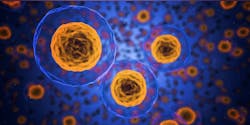MAIT cells may be key to the next wave of immunotherapy and vaccine development
Mucosal-associated invariant T (MAIT) cells, an unconventional form of immune cell, exercise several complex roles during healthy and disease states and may help to serve as a benchmark for future research on these cells as targets for immunotherapies and vaccines, according to new research as described in a news release from Stony Brook University.
The findings were published in the Journal of Immunology.
In recent years, MAIT cells have received increasing attention by researchers because of their abundance in the human body, the fact that they can be rapidly activated by non-peptide vitamin intermediates from microbes, and because of their involvement in both infectious and non-infectious disease processes. Despite emerging interest in MAIT cells, it is not fully understood how they are involved in fighting disease.
“We used single cell RNA sequencing technology and immunologic techniques to reveal that despite being ‘one cell type with a semi-invariant T cell receptor,’ MAIT cells demonstrate marked heterogeneity that recapitulates conventional T cell biology,” explains lead author Charles K. Vorkas, MD, Assistant Professor in the Departments of Medicine, Microbiology and Immunology at the Renaissance School of Medicine at Stony Brook University.
Vorkas and colleagues demonstrated in the laboratory that this marked heterogeneity includes distinct CD4+ and CD8+ lineages, as well as “killer,” “helper,” and “regulatory” cell phenotypes — an indication that MAIT cells exercise complex functions.
He emphasizes that in light of recent studies showing that MAIT cells respond to infectious diseases like COVID-19, as well as during inflammatory events of autoimmune disease such as in lupus, or during tumorigenesis, a better understanding of their roles will help us to develop new therapies.
Vorkas and colleagues are now trying to identify MAIT cell subpopulations responding to initial infection with Mycobacterium tuberculosis, the causative agent of TB disease, as well as to tick-borne infections endemic to Long Island. His lab hopes to harness MAIT cells and other innate lymphocyte populations to develop immunotherapeutic alternatives to antibiotic drugs and to design novel vaccines.

